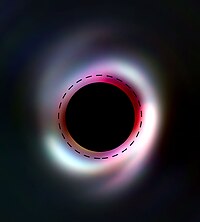Astronomy:HD 100453
Coordinates: ![]() 11h 33m 05.5766s, −54° 19′ 28.5471″
11h 33m 05.5766s, −54° 19′ 28.5471″
| Observation data Equinox J2000.0]] (ICRS) | |
|---|---|
| Constellation | Centaurus |
| Right ascension | 11h 33m 05.5766s |
| Declination | −54° 19′ 28.5471″ |
| Apparent magnitude (V) | 7.79[1] |
| Characteristics | |
| Evolutionary stage | Herbig Ae/Be star[2] |
| Spectral type | A9Ve |
| Apparent magnitude (g) | 7.735[3] |
| Apparent magnitude (B) | 8.07[2] |
| Apparent magnitude (R) | 7.63[2] |
| Apparent magnitude (K) | 5.60[2] |
| Astrometry | |
| Radial velocity (Rv) | 14.597[3] km/s |
| Proper motion (μ) | RA: -36.96±0.02[3] mas/yr Dec.: -5.86±0.02[3] mas/yr |
| Parallax (π) | 9.636 ± 0.022[3] mas |
| Distance | 338.5 ± 0.8 ly (103.8 ± 0.2 pc) |
| Details[2] | |
| Mass | 1.59±0.06 M☉ |
| Luminosity | 6.15±1.07 L☉ |
| Temperature | 7250±250 K |
| Age | 11[4] Myr |
| Other designations | |
CD-53 4102, GSC 08617-01438, HIP 56354, 2MASS J11330559-5419285, TYC 8617-1438-1, Gaia DR3 5345011040956367104 | |
| HD 100453A: | |
| HD 100453B: | |
| Database references | |
| SIMBAD | data |
HD 100453 is a binary star system which lies in the constellation Centaurus about 350 light years away from the Sun and is a member of the open cluster Scorpius–Centaurus association.
Components
The apparent magnitudes of the visible components A and B are 7.8 and 15.9 respectively. The primary is a Herbig Ae/Be star, which is young but no longer accreting mass.[5] The secondary is an M4 class red dwarf star at the projected separation 120 AU from the primary.[6]
Circumstellar disks
The primary star is surrounded by two dust disks, separated by a gap. The disks are orbiting in different planes, misaligned by 72 degrees. The disk misalignment may be caused by a suspected superjovian planet orbiting within the gap,[2] roughly 15–20 AU from the primary.[7] The outer disk has a 2-arm spiral structure caused by the outer stellar companion HD 100453B.[6] The outer disk is rather massive at 0.0174M☉,[8] but is significantly depleted in gas, with a gas-to-dust mass ratio of no more than 4:1.[5]
| Companion (in order from star) |
Mass | Semimajor axis (AU) |
Orbital period ([[]]s) |
Eccentricity | Inclination | Radius |
|---|---|---|---|---|---|---|
| inner disk | 0.315[2] AU | 46.05+0.88−0.92 [2]° | — | |||
| outer disk | 45[6] AU | 33.80+0.77−0.72[2]° | — | |||
The gas present in the disks is unusually depleted in nitrogen and hydrogen-bearing compounds and enriched in carbon monoxide.[4] Molecular hydrogen was not detected.[9] Solid silicate material present in the disks shows good crystallinity, with reduced amounts of amorphous material.[10]
No disks were detected around the companion star HD 100453B, with the upper limit on the amount of dust around it being 0.03 M⊕.[11]
References
- ↑ "HD 100453". SIMBAD. Centre de données astronomiques de Strasbourg. http://simbad.u-strasbg.fr/simbad/sim-basic?Ident=HD+100453.
- ↑ 2.0 2.1 2.2 2.3 2.4 2.5 2.6 2.7 2.8 Bohn, A. J.; Benisty, M.; Perraut, K.; Van Der Marel, N.; Wölfer, L.; Van Dishoeck, E. F.; Facchini, S.; Manara, C. F. et al. (2022), "Probing inner and outer disk misalignments in transition disks", Astronomy & Astrophysics 658: A183, doi:10.1051/0004-6361/202142070
- ↑ 3.0 3.1 3.2 3.3 Vallenari, A. et al. (2022). "Gaia Data Release 3. Summary of the content and survey properties". Astronomy & Astrophysics. doi:10.1051/0004-6361/202243940 Gaia DR3 record for this source at VizieR.
- ↑ 4.0 4.1 Smirnov-Pinchukov, Grigorii V.; Moór, Attila; Semenov, Dmitry A.; Ábrahám, Péter; Henning, Thomas; Kóspál, Ágnes; Hughes, A Meredith; Di Folco, Emmanuel (2022), "Lack of other molecules in CO-rich debris discs: Is it primordial or secondary gas?", Monthly Notices of the Royal Astronomical Society 510: 1148–1162, doi:10.1093/mnras/stab3146
- ↑ 5.0 5.1 Collins, K. A.; Grady, C. A.; Hamaguchi, K.; Wisniewski, J. P.; Brittain, S.; Sitko, M.; Carpenter, W. J.; Williams, J. P. et al. (2009), "Hd 100453: A Link Between Gas-Rich Protoplanetary Disks and Gas-Poor Debris Disks", The Astrophysical Journal 697 (1): 557–572, doi:10.1088/0004-637X/697/1/557, Bibcode: 2009ApJ...697..557C
- ↑ 6.0 6.1 6.2 Dong (董若冰), Ruobing; Zhu (朱照寰), Zhaohuan; Fung (馮澤之), Jeffrey; Rafikov, Roman; Chiang (蔣詒曾), Eugene; Wagner, Kevin (2015), "An M Dwarf Companion and ITS Induced Spiral Arms in the Hd 100453 Protoplanetary Disk", The Astrophysical Journal 816: L12, doi:10.3847/2041-8205/816/1/L12
- ↑ Nealon, Rebecca; Cuello, Nicolás; Gonzalez, Jean-François; Van Der Plas, Gerrit; Pinte, Christophe; Alexander, Richard; Ménard, François; Price, Daniel J. (2020), "Spirals, shadows & precession in HD 100453 – II. The hidden companion", Monthly Notices of the Royal Astronomical Society 499 (3): 3857–3867, doi:10.1093/mnras/staa2721
- ↑ Yu, Si-Yue; Ho, Luis C.; Zhu, Zhaohuan (2019), "A Tight Relation between Spiral Arm Pitch Angle and Protoplanetary Disk Mass", The Astrophysical Journal 877 (2): 100, doi:10.3847/1538-4357/ab1d65, Bibcode: 2019ApJ...877..100Y
- ↑ Carmona, A.; Van Den Ancker, M. E.; Henning, Th.; Pavlyuchenkov, Ya.; Dullemond, C. P.; Goto, M.; Thi, W. F.; Bouwman, J. et al. (2007), "A search for mid-infrared molecular hydrogen emission from protoplanetary disks", Astronomy & Astrophysics 477 (3): 839–852, doi:10.1051/0004-6361:20077846
- ↑ Vandenbussche, B.; Dominik, C.; Min, M.; Van Boekel, R.; Waters, L. B. F. M.; Meeus, G.; De Koter, A. (2004), "Tentative detection of micron-sized forsterite grains in the proto-planetary disk surrounding HD 100453", Astronomy & Astrophysics 427 (2): 519–523, doi:10.1051/0004-6361:20040420, Bibcode: 2004A&A...427..519V
- ↑ Van Der Plas, G.; Ménard, F.; Gonzalez, J.-F.; Perez, S.; Rodet, L.; Pinte, C.; Cieza, L.; Casassus, S. et al. (2019), "ALMA study of the HD 100453 AB system and the tidal interaction of the companion with the disk", Astronomy & Astrophysics 624: A33, doi:10.1051/0004-6361/201834134, Bibcode: 2019A&A...624A..33V
 |


